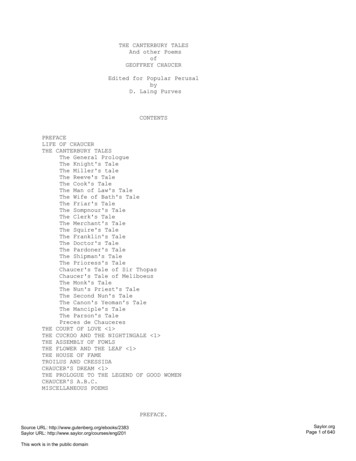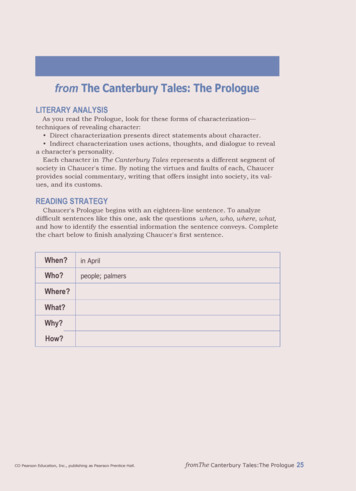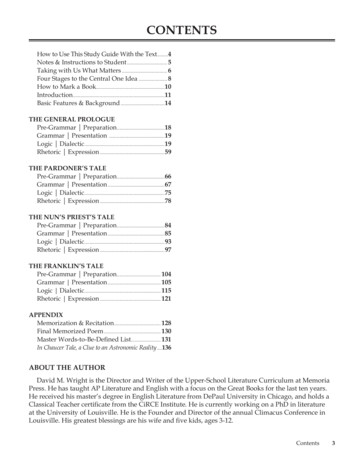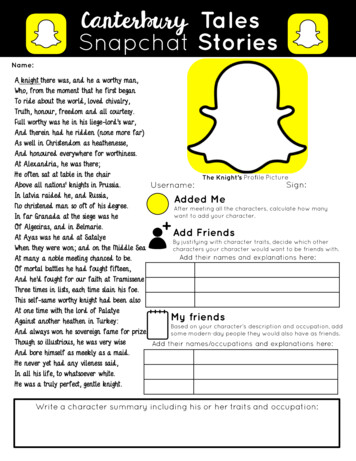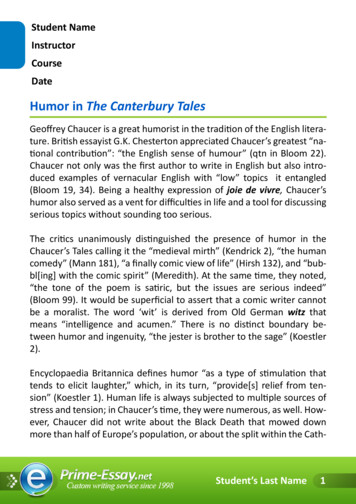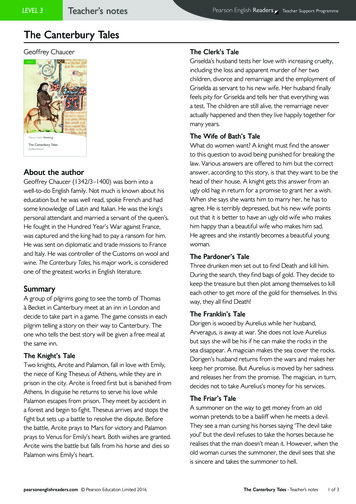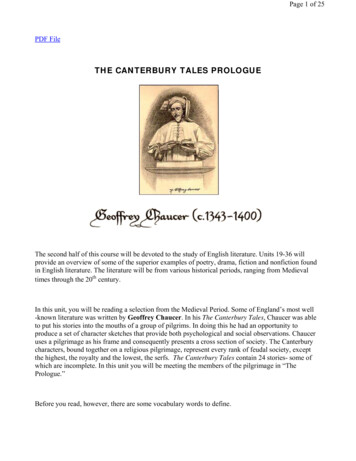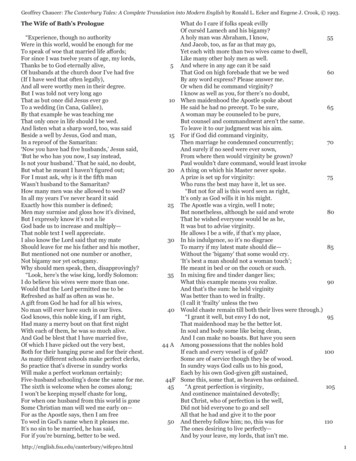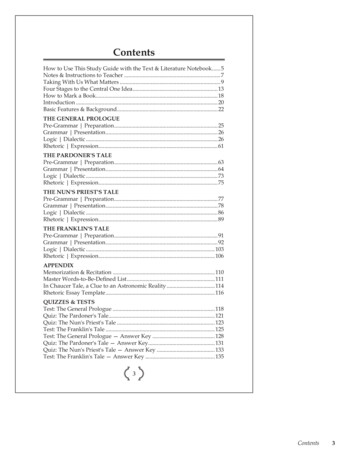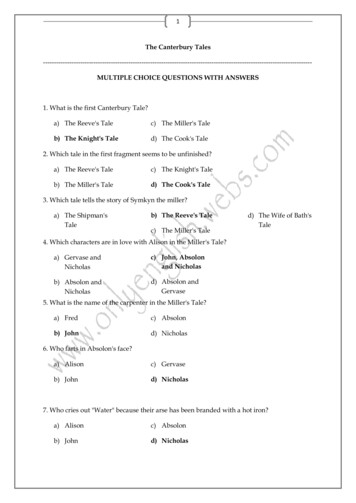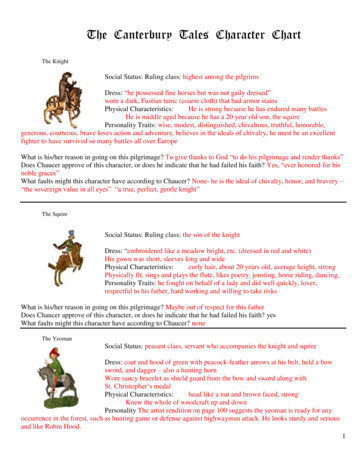
Transcription
The Canterbury Tales Character ChartThe KnightSocial Status: Ruling class: highest among the pilgrimsDress: “he possessed fine horses but was not gaily dressed”wore a dark, Fustian tunic (coarse cloth) that had armor stainsPhysical Characteristics:He is strong because he has endured many battlesHe is middle aged because he has a 20 year old son, the squirePersonality Traits: wise, modest, distinguished, chivalrous, truthful, honorable,generous, courteous, brave loves action and adventure, believes in the ideals of chivalry, he must be an excellentfighter to have survived so many battles all over EuropeWhat is his/her reason in going on this pilgrimage? To give thanks to God “to do his pilgrimage and render thanks”Does Chaucer approve of this character, or does he indicate that he had failed his faith? Yes, “ever honored for hisnoble graces”What faults might this character have according to Chaucer? None- he is the ideal of chivalry, honor, and bravery –“the sovereign value in all eyes” “a true, perfect, gentle knight”The SquireSocial Status: Ruling class: the son of the knightDress: “embroidered like a meadow bright, etc. (dressed in red and white)His gown was short, sleeves long and widePhysical Characteristics:curly hair, about 20 years old, average height, strongPhysically fit, sings and plays the flute, likes poetry, jousting, horse riding, dancing,Personality Traits: he fought on behalf of a lady and did well quickly, lover,respectful to his father, hard working and willing to take risksWhat is his/her reason in going on this pilgrimage? Maybe out of respect for this fatherDoes Chaucer approve of this character, or does he indicate that he had failed his faith? yesWhat faults might this character have according to Chaucer? noneThe YeomanSocial Status: peasant class, servant who accompanies the knight and squireDress: coat and hood of green with peacock-feather arrows at his belt, held a bowsword, and dagger – also a hunting hornWore saucy bracelet as shield guard from the bow and sword along withSt. Christopher’s medalPhysical Characteristics:head like a nut and brown faced, strongKnew the whole of woodcraft up and downPersonality The artist rendition on page 100 suggests the yeoman is ready for anyoccurrence in the forest, such as hunting game or defense against highwayman attack. He looks sturdy and seriousand like Robin Hood.1
What is his/her reason in going on this pilgrimage? He is accompanying the knight and squireDoes Chaucer approve of this character, or does he indicate that he had failed his faith? Yes, “He was a properforester, I guess.”What faults might this character have according to Chaucer? None suggestedThe PrioressSocial Status: clergy (wealthy)– she is a nunDress: veil, graceful cloak, jewely (prayer bracelet) that indicates wealthand worldinessPhysical Characteristics:not undergrown, elegant nose, gray eyes,small, red mouth, wide forehead,Personality Traits: Simple and coy (shy), neat, clean, clingy, helplessCharitable, sympathetic, sentimental, tender-hearted (too much so)What is his/her reason in going on this pilgrimage? She is a nun so a spiritual trip seems likelyDoes Chaucer approve of this character, or does he indicate that he had failed his faith? “He suggests that herdaintiness is too extreme (“her upper lip so clean” being reduced to tears when seeing a mouse in a trap )What faults might this character have according to Chaucer? She is too delicateThe MonkSocial Status: clergy (wealthy)Dress: wealthy, fine fur-trimmed robe, gold broochPhysical Characteristics:he eats wellbald, fatPersonality Traits: Hunter has greyhounds, and hunting shoes with spurs, personablehe likes to eatWhat is his/her reason in going on this pilgrimage? He is a priest but his mission is probably more self indulgentthan spiritualDoes Chaucer approve of this character, or does he indicate that he had failed his faith? His wealthy clothes do notmatch his humble vocation.What faults might this character have according to Chaucer? Instead of devoting his life to work and prayer likemost monks of the Middle Ages, he spends his time hunting and eating.The FriarSocial Status: clergy (weathly)Dress: had a long hanging hood, white, thick neck, rich cape like a PopePhysical Characteristics:instrument and the harpHe sang well and played the hurdy-gurdy stringedPersonality Traits: “Glib with gallant phrase and well turned speech” (He is very2
Persuasive at talking women and wealthly landowners into giving him money inexchange for listening to confessions “an easy man in penance giving”What is his/her reason in going on this pilgrimage? He is a priest but his intentions are dishonest – to make moneyoff selling blessingsDoes Chaucer approve of this character, or does he indicate that he had failed his faith? No, Chaucer is criticizingthe Friar and religious figures like him who are unscrupulous and take advantage of their religious positionWhat faults might this character have according to Chaucer? Instead of remaining tied to one monastery, this friargoes from one wealthy landowner to another accepting bribes in exchange for absolution.The MerchantSocial Status: part of a wealthy trade class of fur traders and clothDress: motley (multi color) dress , wore Flemish beaver hat, daintily buckled bootsPhysical Characteristics:on his horse he sat”forking beard, stately, noble in appearance “highPersonality Traits: Expert at currency exchange but personally in debtWhat is his/her reason in going on this pilgrimage? Perhaps he hopes to sell some of his furs and clothsDoes Chaucer approve of this character, or does he indicate that he had failed his faith? He doesn’t even know hisname.What faults might this character have according to Chaucer? He is supposedly part of the wealthy class but he isactually in debt.The Oxford ClericSocial Status: Middle Class Student of PhilosophyDress: “Thread on his overcoat was bare” his close are ragsPhysical Characteristics:Slender, hollow look, a sober stare (serious)Personality Traits: Studious, read a lot, spent all his money on books, not socialWhat is his/her reason in going on this pilgrimage? He seeks morality and virtue “The thought of moral virtuefilled his speech”Does Chaucer approve of this character, or does he indicate that he had failed his faith? Maybe Chaucer is justtrying to say that studious types retreated from societyWhat faults might this character have according to Chaucer? Whatever money he gets from friends, he spends onbooks, and he doesn’t have a job, but he might become a teacher.3
The Man of LawSocial Status: Middle class lawyer appointed by the KingDress: Homely parti-colored coat, pin striped beltPhysical Characteristics:Not stated – see personality traitsPersonality Traits: Wise, cautious, accurate, knowledgeable in all lawsWhat is his/her reason in going on this pilgrimage? To uphold justiceDoes Chaucer approve of this character, or does he indicate that he had failed his faith? Yes, everybody respectedhim “ a man of reverence”What faults might this character have according to Chaucer? None suggestedThe FranklinSocial Status: middle class - man of leisureDress: had a dagger and white pursePhysical Characteristics:White beard,Personality Traits: Confident, cheerful, lived for pleasureWhat is his/her reason in going on this pilgrimage? To enjoy himselfDoes Chaucer approve of this character, or does he indicate that he had failed his faith? He liked good food, goodwine. He kept a buffet of food ready to eat all day.What faults might this character have according to Chaucer? He was lucky and didn’t serve a nobleman, so he wasa free man.The Tradesmen(Carpetmaker, HaberdaserDyer, Carpenter, Weaver)Social Status: Trade class – group who appear as a unitDress: Stylishly dressed Their gear was trim and fresh, knives wrought with purestsilverPhysical Characteristics:Proud men who represented their guild (their group ofcraftsmen – they are the new emerging middle classPersonality Traits: Seemed like worthy members of a legislative bodyWhat is his/her reason in going on this pilgrimage? To represent their group of upcoming craftsmenDoes Chaucer approve of this character, or does he indicate that he had failed his faith? They are the new middleclassWhat faults might this character have according to Chaucer? Their wives are eager for their husbands to run foroffice so they can move up the social ladder.4
The CookSocial Status: trade class cookDress: unknownPhysical Characteristics:sore on legPersonality Traits: servant to craftsmen, good cook, good sense of tasteWhat is his/her reason in going on this pilgrimage? To cook for the group of upcoming craftsmenDoes Chaucer approve of this character, or does he indicate that he had failed his faith? He feels sorry for himWhat faults might this character have according to Chaucer? Has a sore on his legThe Skipper/ShipmanSocial Status: peasant class - a veteran sailorDress: Woolen gown that reach his knee, dagger hanging from his neckPhysical Characteristics:but ruthlessTan, beardedPersonality Traits: A rascal who he steals wine, he is hardy, he is a skilled navigatorbut ruthless with enemies, able to withstand hardship, careful plannerWhat is his/her reason in going on this pilgrimage? He is well traveled, so he perhaps he wants to continue histravels Does Chaucer approve of this character, or does he indicate that he had failed his faith? See belowWhat faults might this character have according to Chaucer? He steals wineThe DoctorSocial Status: Middle ClassDress: Blood-red garments slashed with bluish-gray, lone with taffeta (silk)Physical Characteristics:see personality traitsPersonality Traits: Well spoken, excellent knowledge of middle ages medical tricksAnd remedies based more on medieval practices like blood-lettingWell connected to local apothecaries who profited like the doctor5
What is his/her reason in going on this pilgrimage? Maybe to make money in case someone gets sickDoes Chaucer approve of this character, or does he indicate that he had failed his faith? “He did not read the Biblevery much.” Although physically healthy, the doctor is unhealthy in spirit.What faults might this character have according to Chaucer? He seemed to be more interested in profiting frompeople’s illnesses than helping people get better.The Wife of BathSocial Status: middle class seamstressDress: kerchiefs finely woven, red hose, new shoesPhysical Characteristics:somewhat deaf, red faced but handsome,gapped teeth, large hipsPersonality Traits: bold, argumentative, well traveled, professional wifeVery socialWhat is his/her reason in going on this pilgrimage? Maybe to meet another husband.Does Chaucer approve of this character, or does he indicate that he had failed his faith? “”a worthy woman”What faults might this character have according to Chaucer? She was married five timesThe ParsonSocial Status: ClergyDress: modest/poorPhysical Characteristics:see personalityPersonality Traits: Holy, virtuous, hard working church man who disliked extortingtithe (taxes paid to church), gave from the church offerings to the poor, he practiceswhat he preachesWhat is his/her reason in going on this pilgrimage? To help others find salvation.Does Chaucer approve of this character, or does he indicate that he had failed his faith? The Parson lives in povertybut is rich in holy thoughts and deeds.What faults might this character have according to Chaucer? None, unlike the monk, friar, and pardoner, he is theonly the devout churchman.The PlowmanSocial Status: peasant, the parson’s good-hearted brotherDress: Wore a loose jacket smock, rode a marePhysical Characteristics:see above and below6
Personality Traits: Honest worker, good and true, loves God and neighbors, helpful tothe poor, pays tithes to the churchWhat is his/her reason in going on this pilgrimage? To accompany his brother, the parson, to praise GodDoes Chaucer approve of this character, or does he indicate that he had failed his faith? Yes, he is a giver.What faults might this character have according to Chaucer? None, lives a good Christian life.The MillerSocial Status: trade class worker who uses equipment to make flourDress: Sword and buckler (shield) at his side, wore a blue hood and white coatPhysical Characteristics:Stout - weighed 224 pounds, big, brawnyred beard, wart on his nosePersonality Traits: Wrestler, steals grain, a loud, bad storytelling clown, playsbagpipesWhat is his/her reason in going on this pilgrimage? To go against conventional thinkingDoes Chaucer approve of this character, or does he indicate that he had failed his faith? No, he is a bruteWhat faults might this character have according to Chaucer? He is a big mouthed and blasphemous.The MancipleSocial Status: Trade Class – provider of provisions for a college or court or monasteryDress: clothing suitable for a trade class that buys supplies for elite groupsPhysical Characteristics: see belowPersonality Traits: Uneducated but clever, smarter than the lawyers he feedsWhat is his/her reason in going on this pilgrimage? He serves food to monasteries so perhaps he wants to servehimself with salvationDoes Chaucer approve of this character, or does he indicate that he had failed his faith? Yes, he is smarter than theelite group he buys food and supplies forWhat faults might this character have according to Chaucer? noneThe ReeveSocial Status: Middle class steward responsible for running the everyday affairs of afeudal manorDress: long overcoat of bluish gray, rusty bladePhysical Characteristics:Old, thin, close shaven, legs like sticks, probably frail7
Personality Traits: Feared like the plague by serfs and herdsmen - those beneath him,Knowledgeable in his jobWhat is his/her reason in going on this pilgrimage? Perhaps he seeks forgiveness for stealing from his master andcreating fear in those who worked for him.Does Chaucer approve of this character, or does he indicate that he had failed his faith? Probably not since he wascruel and a thief – he rode in the back of the cavalcadeWhat faults might this character have according to Chaucer? He grew rich by knowing his job well and stealingfrom his masterThe SummonerSocial Status: clergy - An official who brings persons accused of violating Churchlaw to courtDress: He wore a garland on his head - see drawing on page 113Physical Characteristics: Has leprosy - disgusting red baby face with pus-filledpimples, narrow eyes, black scabby brows and thin beardPersonality Traits: He is a drunk, lecherous, ill-tempered, smelled of garlic andonionsWhat is his/her reason in going on this pilgrimage? Maybe to drink and chase womenDoes Chaucer approve of this character, or does he indicate that he had failed his faith? No, he is not good at his joband takes advantage of his position pretending to know Latin but really only knows a few wordsWhat faults might this character have according to Chaucer? He drinks too much and is a lecher (womanizer)The PardonerSocial Status: clergy - pardons people’s sins for a donation to the churchDress: Carries a bag full of fake religious relics, no hood but a little cap on headBulging eyeballs, has cross on his wallet, pilgrim medal on hatPhysical Characteristics:long, greasy yellow hair, beardlessPersonality Traits: Greedy fraud, shifty, keeps money from blessings to himself,Sneaky, untrustworthy, dishonest, he read and sang sermons wellWhat is his/her reason in going on this pilgrimage? To make money in exchange for forgiving pilgrims for theirsinsDoes Chaucer approve of this character, or does he indicate that he had failed his faith? No, he is a charlatan (fake)What faults might this character have according to Chaucer? He rides with the summoner who also takes advantageof his position; the cross on his wallet symbolizes how he uses the church to line his pockets8
The Host(Harry Bailey)Social Status: trade class - the leader of the groupDress: see belowPhysical Characteristics:large, striking in appearance, manly, bright eyedPersonality Traits: Loud and merry but quick tempered, bold, tactful,Generous, curiousWhat is his/her reason in going on this pilgrimage? To accompany the pilgrims on their journey and select the onewho tells the best story who will be rewarded with a free supperDoes Chaucer approve of this character, or does he indicate that he had failed his faith? YesWhat faults might this character have according to Chaucer? noneCharactersThe PilgrimsThe NarratorA character called Geoffrey Chaucer. We should be wary of accepting his words and opinions as Chaucer’s own. In the GeneralPrologue, the narrator presents himself as a gregarious and naïve character. Later on, the Host accuses him of being silent andsullen. The narrator writes down his impressions of the pilgrims from memory. What he chooses to remember about the characterstells us as much about the narrator’s own prejudices as it does about the characters themselves.The KnightThe first pilgrim Chaucer describes in the General Prologue and the teller of the first tale. The Knight represents the ideal of amedieval Christian man-at-arms. He has participated in no less than 15 of the great crusades of his era. Brave, experienced, andprudent, the narrator greatly admires him.The Wife of BathA seamstress by occupation and an “expert on marriage.” The Wife of Bath has been married five times and had many other affairsin her youth, making her well practiced in the art of love. She presents herself as someone who loves marriage and sex, but, fromwhat we see of her, she also takes pleasure in rich attire, talking, and arguing. She is deaf in one ear and has a gap between her9
front teeth, which was considered attractive in Chaucer’s time. She has traveled on pilgrimages to Jerusalem three times andelsewhere in Europe as well. Bath is an English town on the Avon River, not the name of this woman’s husband.The PardonerA charlatan, who “officially” forgives people’s sins for a price. Pardoners granted papal indulgences—reprieves from penance inexchange for charitable donations to the Church. Many pardoners, including this one, collected profits for themselves. Chaucer’sPardoner excels in fraud, carrying a bag full of fake relics. For example, he claims to have the veil of the Virgin Mary. The Pardonerhas long, greasy, yellow hair and is beardless. These characteristics were associated with shiftiness and gender ambiguity inChaucer’s time. The Pardoner also has a gift for singing and preaching whenever he finds himself inside a church.The MillerStout and brawny, with a wart on his nose and a big mouth, both literally and figuratively. He threatens the Host’s notion of proprietywhen he drunkenly insists on telling the second tale. Indeed, the Miller seems to enjoy overturning all conventions: He ruins theHost’s carefully planned storytelling order, he rips doors off hinges, and he tells a tale that is somewhat blasphemous, ridiculingreligious and scholarly clerks, carpenters, and women.The PrioressA nun who heads a convent. Described as modest and quiet, this Prioress aspires to have exquisite taste. Her table manners aredainty, she knows French (though not the French of the court), she dresses well, and she is charitable and compassionate.The MonkA monk given to corporeal pleasures. Most monks of the Middle Ages lived in monasteries according to the Rule of Saint Benedict,which demanded that they devote their lives to “work and prayer.” This Monk cares little for the Rule; his devotion is to hunting andeating. He is large, loud, and well clad in hunting boots and furs.The FriarAn example of the unscrupulous friars of Chaucer’s time. Roaming priests with no ties to a monastery, friars were great objects ofcriticism in Chaucer’s time. Always ready to befriend young women or rich men who might need his services, the friar activelyadministers the sacraments in his town, especially those of marriage and confession. However, Chaucer’s worldly Friar has taken toaccepting bribes.The SummonerAn official who brings persons accused of violating Church law to ecclesiastical court. This Summoner is a lecherous man whoseface is scarred by leprosy. He gets drunk frequently, is irritable, and is not particularly qualified for his position. He spouts the fewwords of Latin he knows in an attempt to sound educated.The HostThe leader of the group. The Host is large, loud, and merry, though he possesses a quick temper. He mediates and facilitates theflow of the pilgrims’ tales. His title of “host” may be a pun, suggesting both an innkeeper and the Eucharist, or Holy Host.The ParsonThe only devout churchman in the company. The Parson lives in poverty but is rich in holy thoughts and deeds. The pastor of asizable town, he preaches the Gospel and makes sure to practice what he preaches. He’s everything that the Monk, Friar, andPardoner aren’t.10
The PardonerThe Pardoner rides in the very back of the party in the General Prologue and is fittingly the most marginalized character in thecompany. His profession is somewhat dubious—pardoners offered indulgences, or previously written pardons for particular sins, topeople who repented of the sin they had committed. Along with receiving the indulgence, the penitent would make a donation to theChurch by giving money to the pardoner. Eventually, this “charitable” donation became a necessary part of receiving an indulgence.Paid by the Church to offer these indulgences, the Pardoner was not supposed to pocket the penitents’ charitable donations. Thatsaid, the practice of offering indulgences came under critique by quite a few churchmen, since once the charitable donation becamea practice allied to receiving an indulgence, it began to look like one could cleanse oneself of sin by simply paying off the Church.Additionally, widespread suspicion held that pardoners counterfeited the pope’s signature on illegitimate indulgences and pocketedthe “charitable donations” themselves.Chaucer’s Pardoner is a highly untrustworthy character. He sings a ballad—“Com hider, love, to me!” (General Prologue, 672)—withthe hypocritical Summoner, undermining the already challenged virtue of his profession as one who works for the Church. Hepresents himself as someone of ambiguous gender and sexual orientation, further challenging social norms. The narrator is not surewhether the Pardoner is an effeminate homosexual or a eunuch (castrated male). Like the other pilgrims, the Pardoner carries withhim to Canterbury the tools of his trade—in his case, freshly signed papal indulgences and a sack of false relics, including a brasscross filled with stones to make it seem as heavy as gold and a glass jar full of pig’s bones, which he passes off as saints’ relics.Since visiting relics on pilgrimage had become a tourist industry, the Pardoner wants to cash in on religion in any way he can, and hedoes this by selling tangible, material objects—whether slips of paper that promise forgiveness of sins or animal bones that peoplecan string around their necks as charms against the devil. After telling the group how he gulls people into indulging his own avaricethrough a sermon he preaches on greed, the Pardoner tells of a tale that exemplifies the vice decried in his sermon. Furthermore, heattempts to sell pardons to the group—in effect plying his trade in clear violation of the rules outlined by the host.The SquireThe Knight’s son and apprentice. The Squire is curly-haired, youthfully handsome, and loves dancing and courting.The ClerkA poor student of philosophy. Having spent his money on books and learning rather than on fine clothes, the clerk is threadbare andwan. He speaks little, but when he does, his words are wise and full of moral virtue.The Man of LawA successful lawyer commissioned by the king. He upholds justice in matters large and small and knows every statute of England’slaw by heart.The MancipleA clever fellow. A manciple was in charge of getting provisions for a college or court. Despite his lack of education, the Manciple issmarter than the 30 lawyers he feeds.The MerchantA trader in furs and cloth, mostly from Flanders. The merchant is part of a powerful and wealthy class in Chaucer’s society.The ShipmanA well-traveled and well-tanned veteran sailor. The Shipman has seen every bay and river in England, as well as exotic ports inSpain and Carthage. He is a bit of a rascal, known for stealing wine while the ship’s captain sleeps.11
The PhysicianA talented doctor with expertise in diagnosing the causes and finding cures for most maladies. Though the Physician keeps himselfin perfect physical health, the narrator calls into question the Physician’s spiritual health: He rarely consults the Bible and has anunhealthy love of financial gain.The FranklinA man of leisure. The word franklin means “free man.” In Chaucer’s society, a franklin was neither a vassal serving a lord nor amember of the nobility. This particular franklin is a connoisseur of food and wine—so much so that his table remains laid and readyfor food all day.The ReeveA shrewd steward of a manor. This reeve’s lord never loses so much as a ram to the other employees, and the vassals under hiscommand are kept in line. However, he steals from his master.The PlowmanThe Parson’s brother and an equally good-hearted man. A member of the peasant class, he pays his tithes to the Church and leadsa good Christian life.The GuildsmenA hatmaker, carpenter, weaver, clothing dyer, and a tapestry maker. The Guildsmen appear as a unit. English guilds were acombination of labor unions and social fraternities: Craftsmen of similar occupations joined together to increase their bargainingpower and live communally. All five Guildsmen are clad in the livery of their brotherhood.The CookThe Guildsmen’s cook. The Narrator gives little detail about him, but he does mention a crusty sore on the Cook’s leg.The YeomanThe servant who accompanies the Knight and the Squire. The Narrator mentions that the Yoeman’s dress and weapons suggest hemay be a forester.The Second NunNot described in the General Prologue. She tells a saint’s life for her tale.The Nun’s PriestAlso not described in the General Prologue. His story of Chanticleer, however, is well crafted and suggests that he is a witty, selfeffacing preacher. Ruling Class: knight, squire Clergy:monk, friar, prioress, parson Middle Class: Franklin, Reeve, doctor,oxford student, wife of Bath,serjeant at law Trade Class: guildsmen, cook, miller, host,manciple, merchant. Peasants:skipper, plowman, yeomansummoner, pardoner12
The Canterbury Tales Character Chart The Knight Social Status: Ruling class: highest among the pilgrims Dress: “he possessed fine horses but was not gaily dressed” wore a dark, Fustian tunic (coarse cloth) that had armor stains Physical Characte
